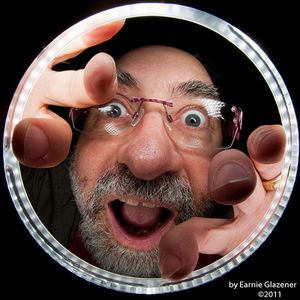I was in the middle of teaching a 10-week Introduction to Studio Lighting class at PCNW and started putting this together for my students. It was stimulated by online discussion groups and forums where I see basically the same questions come up with many incorrect answers. I often feel that people are parroting back something they heard or read about, but never actually tried out themselves. Lots of confusion about controlling hot spots in a portrait or product photo. Not understanding what diffusion is or does. Misunderstanding how light modifiers work and what their role is. And much, much more. Much of this post will be a rehash of topics I have covered in previous posts, but I think that the repetition is good. So, let’s start today with modifiers. What is the difference between a silver umbrella and a diffused umbrella? How do they affect the look of the subject?
The subject is more important than the modifier
In these examples I am comparing a small light source with a large light source at the same distance and with and without diffusion on the large light source. Then I compare the large light source at two different distances with and without diffusion. My aim is to show the effects of size, distance, and diffusion as well as how the subject itself influences the look by what the subject presents back to the camera. Some of the things to watch for are the softness of the light as shown by the shadow edge transition (sometimes called the "quality" of light, but that term might be too subjective), the density of the shadow--are the shadows dark or are they open, and the size and brightness of specular highlights.
The photos are made up of highlights that are mirror-like reflections of the light source itself, the true tone or value of the objects, and the shadows where the light doesn't reach. In between these we have the transitions--how smoothly or abruptly the light goes from highlight to shadow.
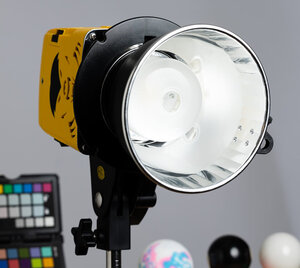
I start with A, the small hard light source. In this case a 6-inch polished silver bowl reflector as shown here at 40 inches from the set of objects. As you can see with this light source the balls on the table cast dark shadows with hard edges. The shiny black surface of the 8 ball shows the direct reflection of the light. The cue ball and the bath ball have an obvious round shape, but don't show the direct reflection very well, if at all. The different surfaces present themselves differently. There is a highlight down the length of my nose and tiny catchlights in my eyes. My iris's are not very well lit. The light is coming from camera right and we see falloff across my face towards camera left.
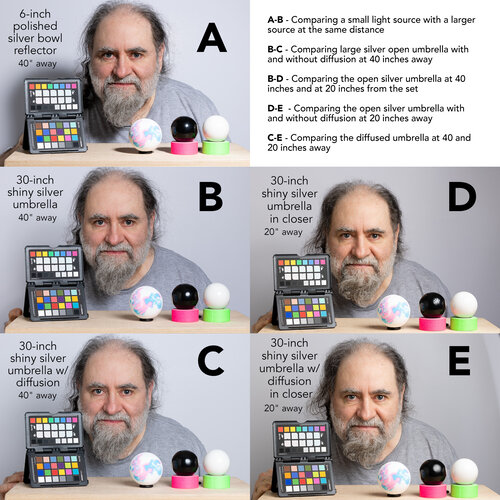
In B I have switched to a larger light source. This time a shiny silver surface umbrella. The notable changes here are the larger catchlights and the larger highlight in the 8 ball where you can see the direct reflection of the umbrella and the larger light "wrapping" around to give more coverage across my face and lighter toned shadows of the balls on the table. The larger light source also softens the shadow edge transition for a softer light. The brightness of the highlights on my nose look pretty similar. You can start to make out the direct reflection in the cue ball, but the bath ball looks the same.
In C I have added a diffusion sheet over the umbrella that is the same size as the umbrella. Being the same size the shadow edge transitions are the same (no change in the softness of the light), but the diffuser spreads the light out around the room (environmental bounce) and makes the shadows and the background become brighter even though the light to subject to background remains the same. The highlight in the 8 ball is more diffuse, but still the most noticeable highlight along with the catchlights. The highlight on my nose is still pretty much the same. The diffusion on the light is not changing the softness of the light or the specularity of the reflections. It is just spreading the light out in a wider pattern.
In D I have taken the silver umbrella without diffusion and brought it in to half the distance (20 inches) from the set. The background has gone darker (the closer the light is to the subject, the darker the background becomes). The highlight in the 8 ball and the highlights on my nose are now larger and appear to be dimmer. They are still the same brightness as the light source, but I had to lower the power of the light to keep the true tone values in the scene from overexposing. By bringing the light in to half the distance and keeping the true tone values correctly exposed I have darkened the highlights by 2 stops (1/4 of how bright they were at 40 inches). The silver umbrella is directional so the environmental fill is less. The shadows of the balls on the table have a soft edge, but are dark. The shadow edge transition and the tone of the shadows are independent of each other. The transition is controlled by the size of the light as seen by the subject (larger = softer) and the shadow density is controlled by the spread of the light and the environment. Again, the cue ball and the bath ball show no difference.
In E I have added the diffuser back on the umbrella. This spreads the light around the room making for lighter toned shadows and a slightly lighter background. But the softness of the light stays the same because the size is the same. Distance is also the same and we see the nose highlights remaining the same with and without the diffuser in place. Again, the cue ball and the bath ball show no difference.
To recap:
Light modifiers do specific things: Efficiency (silver is brighter than white), light spread (silver is narrower than white), softness (bigger is softer than smaller), coverage (round produces a more even shadow around the subject), and color (the material can impart a color cast). What the modifier doesn’t do is affect the specularity of the subject. No matter which modifier you use, a shiny surface will have a shiny reflection and a mat surface will look mat.
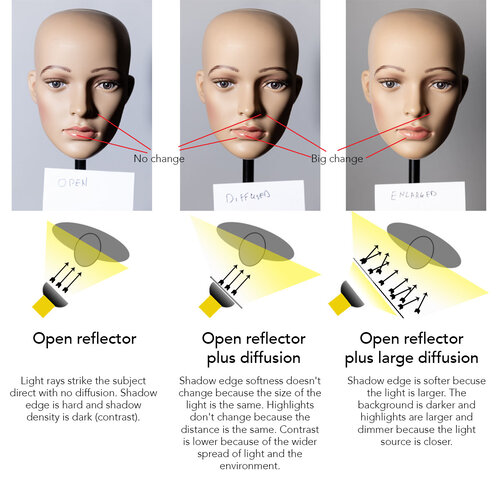
Diffusion directly on a light source, the same size as the light source spreads the light out in a wider pattern. I know that people say things like “I added diffusion to soften the light” or “I added diffusion to tone down the highlights on the skin” or “I used multiple layers of diffusion to soften the light.” Sorry, that’s not how it works. Diffusion does not change the softness of the light or the specularity of the subject. Diffusion spreads the light out into a wider pattern. Depending on the environment it will brighten up the shadows from bouncing off more surfaces around the subject. But it doesn’t change the shadow edge transition. Shadow density (contrast) and shadow edge transition (softness) are separate issues. You can have hard edged but light toned shadows or soft edges with dark shadows.
To make the light softer you have to make it larger in relation to the subject. You can do this with diffusion, but the diffusion needs to be significantly larger than the light origin and separated from the light origin. To make shadows brighter you need to surround the subject with white/neutral surfaces like foamcore or v-flats to be reflected by the subject. To make the shadows darker you need to surround the subject with dark/neutral surfaces to be reflected by the subject.

We often talk about "fill" cards, but with white and black cards the term reflectors is more descriptive. Look at the 8 ball where you can see a reflection of the other balls, the roll of tape it sits on, and a reflection of myself. Reflections, not fill light. The same with portrait photography. Bring in a white card to reflect the card to open up the shadows or bring in a black card to be reflected by the skin to darken a side of the face. A white card and obviously a black card cannot be brighter than the light it reflects and will not cause a shadow. However, a shiny silver card can act like an additional light source.
The distance between the light and the subject affects the depth and spread of the light. The farther the light is away, the wider the photons spread out. At the same time those rays that do hit the subject are more parallel. The wider spread makes the light bounce off the environment and the "parallel" rays penetrate deeper into the scene. Overall contrast is lower between the subject and the background, but the shadow edges get harder due to the light getting relatively smaller over greater distances. The light reflecting off the subject gets dimmer as the light to subject distance increases and fewer photos hit the subject.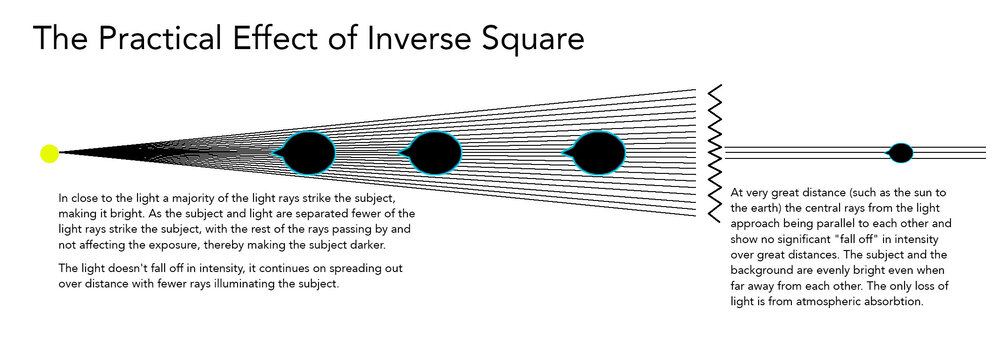

Inverse Square Law
This is based on the Inverse Square Law. The light appears to get dimmer in inverse proportion to the square of the distance. Double the distance and you get 1/4 the light on the subject. Triple the distance and get 1/9 the amount of light—for the diffuse true value reflections determining the proper exposure. But look at the specular highlights. They stay the same brightness when the distance changes. Does that violate the inverse square law? No. Instead the size of the reflection varies in inverse proportion to the change in distance. This is how we control hot spots. It might seem counter-intuitive at first, but to reduce the hot spots you need to bring the light in closer. Yes the light gets brighter, but don't confuse bright with harsh. You can control the brightness by turning the power of the light down.
What is happening when you bring the light in closer is that the hot spot gets larger (making it less noticeable) while remaining the same brightness. At the same time, though, the true value gets brighter and you have to lower the exposure. So if you cut the distance to 1/3 the original distance and adjust the exposure to correct for the diffuse reflection the highlight is 9x dimmer in relation. If you half the distance the hotspots are 4x dimmer.

It is all a big balancing act
At some point you come to realize that photography is a series of trade-offs. Shutter speed vs aperture. Aperture vs depth of field. Shutter speed vs motion blur. Same thing in lighting. Do you change the light to subject distance to control the hotspots? That also changes the depth and spread of the light. Bring the light in closer and in addition to making the hot spots less noticeable it also makes the background go darker and the falloff from highlight to shadow side of the face gets a softer transition that happens more quickly. And this brings us to answering the question as to why there are so many sizes of light modifiers such as umbrellas, soft boxes, octaboxes, and the like.
Let's take a step back and look at the considerations I go through when setting up a portrait.I will pick the f/stop I want for depth of field. I will pick the light to subject distance for depth of light. Then pick the size of the light for the shadow edges I want. Larger light gives softer light.
Once I have determined the light to subject distance I don't want to move the light. So to control the softness of the light I need change the size of the modifier. If the light is too hard switch to a larger modifier. If the light is too flat try a smaller modifier. The size of the softbox does NOT change the coverage of the softbox. At the same distance a 16x24 box, a 24x36 box, and a 36x48 box cover the same area of the scene but the shadow edges will be different as seen on the right.
